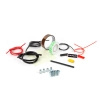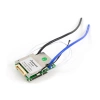Self-assembly bicycle battery Kirin - 48V 13s7p 13 - 17,5Ah
- Battery available in capacity:
Gain a discount when buying products from the collection
In collection
Self-assembly bicycle battery 13s5p 48V Kirin

Advantages of installing the battery yourself:
The set includes::
PACKAGE 13S 5P
Lithium-ion pack. It is the main element for the construction of the battery. After soldering the matching BMS, it is ready for operation.


BMS
Battery management system (BMS) - it is a device that automates the entire process of using batteries. After connecting the appropriate charger to the BMS, it supervises its proper charging and discharging. It is an integral part of a properly built electric bike.
Lithium batteries (lithium ion, lithium polymer and others) are serviceable and require care and attention. They cannot be charged above 4.2V per cell or discharged below 3V per cell. To monitor them in everyday use, a device called BMS was invented.
ACCESSORIES FOR THE CONSTRUCTION OF A DOWN TUBE BATTERY
- red wire 12 AWG - 1m
- black wire 12 AWG - 1m
- red wire 16 AWG - 0,5m
- black wire 16 AWG - 0.6m
- epoxy glass, insulator, fiberglass - 12,5mm x 12,5mm
- thick thermo tube - 10,0mm 1 x 12cm
- medium thermo tube - 6,4mm 1 x 12cm
- connector xt60 complet
- double-sided adhesive tape
- Kapton tape
- spiral, cable cover - 0,65 m
- rivet nuts and mounting screws- 4 pcs


Battery case
The case will hold 70pcs 18650 cells. It has a built-in power indicator.
The set also includes a mounting rail.
Solid battery case, mounted to the bicycle frame. Pulls out sideways.
You have to see - Akademia E-bike
Watch the battery installation video by "Tas". Learn how to build a battery yourself by watching the video below.

Instructions for building a down tube battery Kirin 13s5p | Akademia E-bike
Attention:
Do not connect this battery model to the Mxus 3K Turbo 3000W MTB kit.
You don't know if the battery case will fit your bike frame? Download the templates and print at a scale of 1:1, after printing, check whether both marked dimensions of 50mm are consistent with reality, otherwise the casing could have been printed in a different scale and the dimensions will not match
Download a battery template for fitting in a bicycle frame - Click here
Remember to connect the charger to the batteries in the correct order. ALWAYS first connect the charger to the 230V socket and then to the charging socket. DO NOT connect it the other way around. This may quickly damage both the charger and the BMS installed in your battery. The reverse connection causes the effect of sudden charging of the charger's output capacitors through the BMS socket. This is accompanied by the flow of huge current that can damage the plug, socket, BMS mosfets or even charger transistors.
The actual capacity of the package (available capacity) is always smaller than the rated capacity of the package (rated capacity of the cells it contains). It is assumed that the finished battery based on the package will have approximately 10% less real capacity than the theoretical rated capacity. This is caused by many factors, such as a decrease in cell capacity under load or the BMS leaving unused capacity (discharging to the minimum cell voltage of approximately 2.7V) in order to extend the battery life.
If your BMS has a turn-on circuit (two white wires) and it is disconnected (the wires are not shorted), it must be connected (short-circuited the wires) to turn on the BMS.

Each battery in the nexun.pl online store is covered by a 24-month warranty for consumers and a 12-month warranty for companies.
The warranty covers:
- Cell damage
- BMS damage
- Capacity decline (over 15% per year)
The warranty does not cover:
- Errors in assembly that do not comply with the instructions or workmanship
- Improper maintenance
- Mechanical damage (cracked/broken casing, melted connection terminals, etc.)
- Changes in the product's operating characteristics depending on weather conditions (temperature)
- Water damage
To maximize battery life, use the following recommendations:
1. Fully charge the battery after each ride
2. Fully charge the battery every 3-4 weeks when you do not use it, e.g. winter break.
3. In the autumn and winter (temperature below +12*C), lithium-ion batteries have a lower capacity (by max. 30%) than in the summer, which results in a shorter range. This is normal. During this period, do not use the full power for the first 10-15 minutes of riding.
4. Do not charge the battery with a current higher than 3A.
















